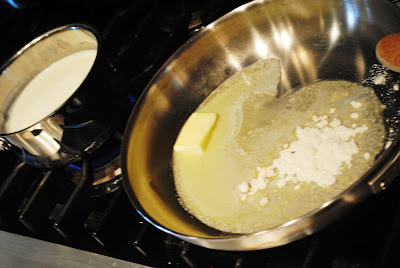This is luxury on a plate. When preparing this dish, you must get by the thought of caloric intake and savor every moment. Remember, moderation is key in everything in life, so why not indulge?
Artichokes are so misunderstood, especially in the Southern, United States, where you more than likely going to see it used as a decoration rather than in a recipe. I order mine by mail here in Tupelo, MS. On occassion, they do show up locally. Look for small, firm artichokes in your local market. Baby varieties are showing up now. This is a great time to try this fantastic recipe.
Here is a Northern, Italian Classic you will be making time after time. I normally use fresh pasta sheets, but did not have time to make them. A good, quality, box variety is key to a good result. You want a firm texture on the plate.
Ingredients:
9 medium, baby, seasonal artichokes, cut, cleaned, center removed
2 teaspoons salt
One fresh lemon sliced
several liters of fresh water
Cut and clean your artichokes. Remove your green parts until you begin to see some lighter yellow leaves. Cut the tips off. With a sharp knife, remove the center thistle. Split in half and place in lemon water. This will help retain the artichokes color.
Bring several liters of water to a boil. Add salt and bring to a boil.
Add your artichokes and a tablespoon of butter. Boil your artichokes for about 30 minutes on simmer.
Test the artichokes pieces by poking with a fork. Do not worry if they fall apart some while they cook. They should be nice and soft. Drain, reserving your water. The water has great artichoke flavor. Add some additional cold water and place the pot on the fire to boil. I like to use some of the artichoke water as it will give the pasta additional flavor and some interesting color. Add a tablespoon of salt. Be sure and use the same pot, without rinsing it, just be sure its large enough to boil your lasagna sheets.
Cook your lasagna sheets until almost done. Drain in a colander and separate your sheets to cool. You will need a small, deep, baking dish about an 8x11.
3/4 of a pound lasagna sheets.
2 cups of Parmigiano Reggiano cheese grated
Additional pieces of butter for the top of your baking dish
Parsley to garnishf
This recipe will serve 6 portions.
While your water is coming up to boil, prepare your Bechamel. Bechamel is a white cream sauce, made up of whole milk, flour and butter.
Ingredients:
3 cups of milk
5 tablespoons of unsalted butter
pinch of salt
pinch of nutmeg
4 tablespoons flour
Method: You will need a wide, flat skillet for the bechamel. The sauce needs to aerate. (Thank you, Marcella Hazan). Do not use a deep pan. I have made this mistake one to many times. A simple adjustment made all the difference. A wide open skillet, like a frying pan will do nicely. This takes a little practice. Heat your milk until warm to the touch and slight bubbles are forming around the edges. Turn the heat off under your milk. Heat your butter on low until melted. Add your flour a little at a time incorporating it into the butter. You do not want to darken your flour.
You just want it golden, soaking up your butter.
After you have added all of your flour, begin incorporating your warmed milk a little at a time. Add a large pinch of salt (about a teaspoon of each), and your nutmeg. Keep mixed until smooth and you have used up all of your warmed milk. Your result should be a very smooth consistency.
At this point butter your baking dish and set it aside. Into a bowl combine your artichokes, one cup of Parmigiano cheese and one cup of Bechamel. Gently fold your fixture. You can cut your artichokes into smaller pieces if you like. Take about a tablespoon of Bechamel and coat the bottom of your baking dish lightly. Add your first sheet layer. Smother your artichoke mixture, a couple of additional tablespoons of bechamel and some additional Parmigiano. Keep going until you get to the top. Place additional pieces of butter on top. Bake in a preheated, 375 degree oven for 15 minutes until your top is golden. Let rest for 5 minutes and serve immediately.
Special Note: You can make it a day ahead by covering it with plastic wrap and placing it in your refrigerator. Remove it from the refrigerator approximately one hour before placing it in the hot oven. Buon Appetito.
My variation adapted from Marcella Hazan's Book, "Essentials of Classic Italian Cooking." A fabulous cookbook, everyone who cooks and even if you don't, should live by. Thank you to Marcella Hazan for her wise words and always wonderful advice. I now can consider myself an expert in making Bechamel. Who knew a pan and some determination could make such a difference?











